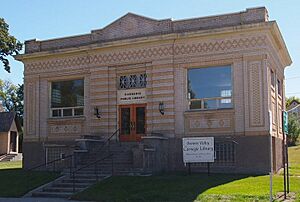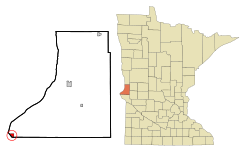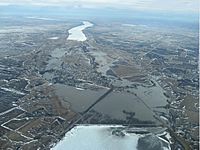Browns Valley, Minnesota facts for kids
Quick facts for kids
Browns Valley
|
|
|---|---|

Browns Valley Carnegie Library
|
|

Location of Browns Valley
within Traverse County, Minnesota |
|
| Country | United States |
| State | Minnesota |
| County | Traverse |
| Area | |
| • Total | 0.78 sq mi (2.02 km2) |
| • Land | 0.78 sq mi (2.02 km2) |
| • Water | 0.00 sq mi (0.00 km2) |
| Elevation | 988 ft (301 m) |
| Population
(2020)
|
|
| • Total | 558 |
| • Estimate
(2021)
|
546 |
| • Density | 714.47/sq mi (275.87/km2) |
| Time zone | UTC-6 (CST) |
| • Summer (DST) | UTC-5 (CDT) |
| ZIP code |
56219
|
| Area code(s) | 320 |
| FIPS code | 27-08200 |
| GNIS feature ID | 0659752 |
Browns Valley is a small city in Traverse County, Minnesota, United States. It is located right next to the border of South Dakota. In 2020, about 558 people lived there.
Browns Valley is special because it sits between two lakes: Big Stone Lake to the south and Lake Traverse to the north. These lakes and the nearby Little Minnesota River are all part of a very old riverbed called the Traverse Gap. This area was once a huge river that drained a giant ancient lake called Glacial Lake Agassiz.
Contents
History of Browns Valley
Browns Valley was first settled in 1867 by a person named Joseph R. Brown. The city was named after him. The town was officially planned out in 1878.
A post office opened in 1867, first called Lake Traverse. It was later renamed Browns Valley in 1872. Two important buildings in the city are listed on the National Register of Historic Places. These are the 1864 Fort Wadsworth Agency and Scout Headquarters Building, and the 1916 Browns Valley Carnegie Library.
Geography and Location
According to the United States Census Bureau, Browns Valley covers about 0.79 square miles (2.02 square kilometers) of land. There is no water area within the city limits. The city is located in a valley that was carved out by glaciers long ago.
The Traverse Gap
Browns Valley is right in the middle of the Traverse Gap. This is a unique valley that was once a huge riverbed. It's also home to a continental divide. This divide is the southernmost point where water flows either north towards the Arctic Ocean or south towards the Atlantic Ocean.
The area is also famous for the discovery of Browns Valley Man. These are the oldest human remains found in Minnesota. Scientists believe they are about 9,000 years old.
Main Roads
The main roads that go through Browns Valley are Highway 27 and Highway 28.
Climate and Weather
Browns Valley can get quite warm in the summer. It has recorded some of the highest summer temperatures in Minnesota. For example, on July 31, 2007, the temperature reached 107°F (42°C). Winters can be very cold, with temperatures sometimes dropping to -40°F (-40°C).
The city gets about 25 inches (64 cm) of rain each year. It also gets about 44 inches (112 cm) of snow annually.
People of Browns Valley
| Historical population | |||
|---|---|---|---|
| Census | Pop. | %± | |
| 1880 | 64 | — | |
| 1890 | 498 | 678.1% | |
| 1900 | 721 | 44.8% | |
| 1910 | 1,058 | 46.7% | |
| 1920 | 1,073 | 1.4% | |
| 1930 | 981 | −8.6% | |
| 1940 | 1,075 | 9.6% | |
| 1950 | 1,117 | 3.9% | |
| 1960 | 1,033 | −7.5% | |
| 1970 | 906 | −12.3% | |
| 1980 | 887 | −2.1% | |
| 1990 | 804 | −9.4% | |
| 2000 | 690 | −14.2% | |
| 2010 | 589 | −14.6% | |
| 2020 | 558 | −5.3% | |
| 2021 (est.) | 546 | −7.3% | |
| U.S. Decennial Census 2020 Census |
|||
In 2010, there were 589 people living in Browns Valley. There were 247 households, and 141 of them were families. The city had about 745 people per square mile.
Most of the people in Browns Valley were White (75.2%). About 21.4% were Native American. The average age of people in the city was 48.3 years old. About 22.2% of residents were under 18 years old.
Notable People from Browns Valley
Some well-known people have connections to Browns Valley:
- Charles Burnett: An officer who served in the Royal Air Force during World War I and World War II.
- Osborne Cowles: A famous basketball coach.
- Charles M. Dale: He was the 66th governor of New Hampshire.
- Kathy Skroch: A member of the North Dakota House of Representatives.
- Arthur C. Townley: A politician.
Flooding in Browns Valley
In March 2007, Browns Valley experienced a major flood. The Little Minnesota River overflowed its banks, causing water to come from the north and west. About 100 people had to leave their homes for safety. This was a large number of people for a small town. The damage was so serious that the Governor of Minnesota, Tim Pawlenty, and Congressman Collin Peterson visited the town.
See also
 In Spanish: Browns Valley (Minnesota) para niños
In Spanish: Browns Valley (Minnesota) para niños


